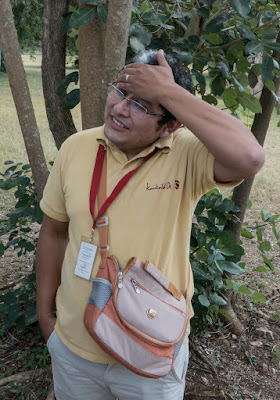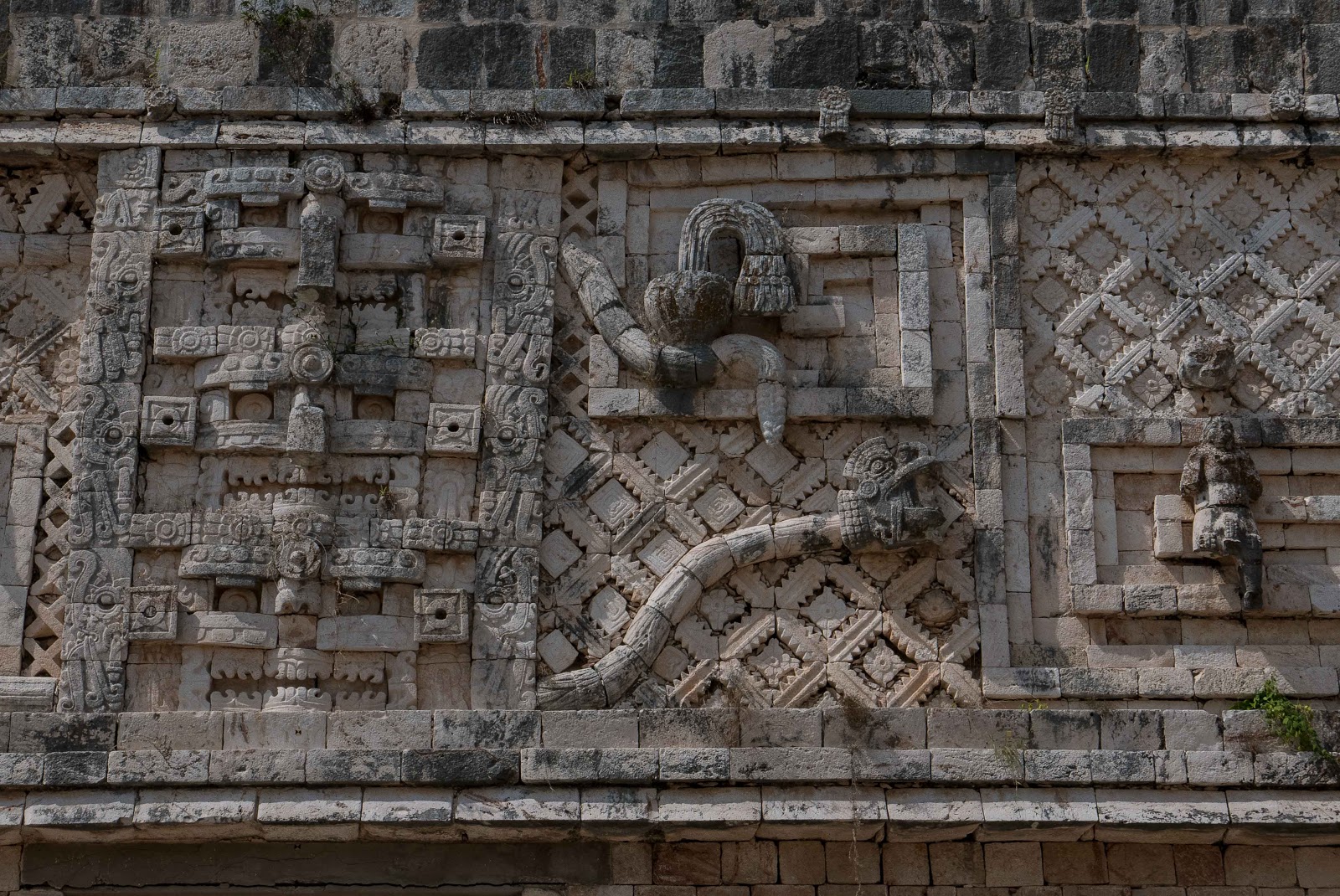 |
|
La pirámide de la mago
|
"La
pirámide es una imagen del mundo; a su vez, esa imagen del mundo es una
proyección de la sociedad humana. Si es
cierto que el hombre inventa dioses a su semejanza, también lo es que encuentra
su semejanza en las imágines que le ofrecen el cielo y la tierra. El hombre
hace del paisaje inhumano historia humana; la naturaleza conviete la historia
en cosmogonía, danza de astros." Octavio Paz, Crítica de la pirámide.
 |
| Guía, Alfredo |
Uxmal,
localizado en la región de Puuc, a 62 km al sur de Mérida, capital de Yucatán,
se considera uno de los sitios arqueológicos más importantes de la cultura
maya. El sitio es una sabana de la hierba seca, rodeada por el bosque. A diferencia de la mayoría de otras ciudades
prehispánicas, Uxmal no fue establecido geométricamente. Su espacio se organizó
en relación con fenómenos astronómicos, como la salida y la puesta de Venus, y
adaptada a la topografía del lugar, compuesto por una serie de colinas. En Puuc arquitectura de las fachadas de los
edificios se dividen en dos elementos horizontales, el inferior es liso y rota
solamente por las puertas mientras que la superior está ricamente decorada con
motivos simbólicos donde los bloques individuales conforman una forma de
mosaico. Serpientes entrelazadas y, en
muchos casos las serpientes de dos cabezas son usadas para máscaras de Dios de
lluvias, Chaac. Incluso antes del
trabajo de restauración, Uxmal estaba en la mejor condición que muchos otros
sitios mayas. Mucho fue construido con
piedras bien cortadas, situado en un núcleo de hormigón no depender de yeso
para sostener el edificio juntos. La arquitectura Maya aquí se considera sólo
comparable a la de Palenque en elegancia y belleza. Gracias a su buen estado de conservacion, es
una de las pocas ciudades mayas donde el visitante ocasional puede obtener una
buena idea de cómo se veía el centro ceremonial en la antigüedad.
Como
Chichén Itzá, la mayor parte de la construcción ocurrió mientras Uxmal era la
capital de un estado maya aproximadamente 850-925 d. C. Algún día después 1000
d. C., los invasores de Toltec asumieron, y la mayor parte de construcción cesó
hacia 1100 d. C. Jean-Frederic Waldeck
publicó la primera descripción detallada del descubrimiento de las ruinas en
1838. La cuenta de Waldeck de Uxmal
inspiró a John Lloyd Stephens y su amigo, el dibujante, Frederick Catherwood, a hacer dos visitas ampliadas al
sitio en 1839-1841, para registrar y dibujar la disposición de la ciudad. Describiendo su primer punto de vista de las
ruinas, Stephens escribe: "Tomamos otro camino, y, surgiendo de repente de
los bosques, a mi asombro vino inmediatamente a un campo abierto grande
esparcido por montículos de ruinas, y edificios enormes en terrazas y
estructuras piramidales, magníficas y en la preservación buena, ricamente
ornamentada, sin un arbusto para obstruir la vista y en efecto pintoresco casi
igual a las ruinas de Tebas...
 |
| La pirámide de la mago como dibujado por Frederick Catherwood |
La
pirámide del adivino o pirámide del enano es una estructura de pirámide
escalonada, inusual entre las estructuras mayas que sus contornos son elípticas
en forma, en lugar del plan rectilíneo más común. Era una práctica común en Mesoamerica para
construir nuevos templos encima de más viejo, pero aquí una pirámide más nueva
fue construida centrada ligeramente al este de la pirámide más vieja, de modo
que en el lado de Oeste el templo encima de la vieja pirámide sea conservado,
con el templo más nuevo encima de ello. Además,
la escalera occidental de la pirámide está situada de modo que esté enfrente
del sol que se pone en el solsticio de verano.
"The
pyramid is an image of the world; in turn, that image of the world is a
projection of human society. If it is true that man invents gods in his own
image, it is also true that he sees his own image in the images that the sky
and the earth offer him. Man makes human history of the inhuman landscape;
nature turns history into cosmogony, the dance of the stars." Octavio Paz,
Critique of the pyramid.
 |
|
The Nunnery Quadrangle (a nickname given by the
Spanish) is the finest of Uxmal's several quadrangles. It has elaborately
carved façades on both the inside and outside faces.
|
 |
| The upper level is richly decorated with symbolic motifs with the individual blocks making up a form of mosaic |
 |
| A drawing by Frederick Catherwood |
Uxmal,
located in the Puuc region, 62 km south of Mérida, capital of the Yucatán, is considered
one of the most important archaeological sites of Maya culture. The site is a dry grass savanna, surrounded
by forest. Unlike most other pre-Hispanic towns, Uxmal was not laid out
geometrically. Its space was organized in relation to astronomical phenomena,
such as the rising and setting of Venus, and adapted to the topography of the
site, made up of a series of hills. In Puuc architecture the facades of
buildings are divided into two horizontal elements, the lower is plain and
broken only by doorways while the upper is richly decorated with symbolic
motifs where the individual blocks make up a form of mosaic. Entwined snakes
and, in many cases two-headed snakes are used for masks of the rain god, Chaac. Even before the restoration work, Uxmal was
in better condition than many other Maya sites. Much was built with well-cut
stones set into a core of concrete not relying on plaster to hold the building
together. The Maya architecture here is
considered matched only by that of Palenque in elegance and beauty. Thanks to
its good state of preservation, it is one of the few Maya cities where the
casual visitor can get a good idea of how the entire ceremonial center looked
in ancient times.
 |
| The view from the Governor's Palace back towards the nunnery and Pyramid of the Magician |
Like
Chichén Itzá, most of the construction took place while Uxmal was the capital
of a maya state around 850-925 AD. Sometime after 1000 AD, Toltec invaders took
over, and most construction ceased by 1100 AD.
Jean-Frederic Waldeck published the first detailed account of the
discovery of the ruins in 1838. Waldeck’s account of Uxmal inspired John Lloyd
Stephens and his illustrator friend, Frederick Catherwood, to make two extended
visits to the site in 1839-1841, to record and sketch the layout of the complex.
From his notes, Stephens published his now famous Incidents of Travel in the
Yucatan. Describing his first view of
the ruins, Stephens writes: "We took another road, and, emerging suddenly
from the woods, to my astonishment came at once upon a large open field strewed
with mounds of ruins, and vast buildings on terraces, and pyramidal structures,
grand and in good preservation, richly ornamented, without a bush to obstruct
the view, and in picturesque effect almost equal to the ruins of Thebes...
 |
| The Pyramid of the Magician is a unusual among Maya structures in that its outlines are elliptical in shape |
The
Pyramid of the Magician, or the Pyramid of the Dwarf is a stepped pyramid
structure, unusual among Maya structures in that its outlines are elliptical in
shape, instead of the more common rectilinear plan. It was a common practice in
Mesoamerica to build new temples atop older ones, but here a newer pyramid was
built centered slightly to the east of the older pyramid, so that on the west
side the temple atop the old pyramid is preserved, with the newer temple above
it. In addition, the western staircase of the pyramid is situated so that it
faces the setting sun on the summer solstice.
 |
| Here a newer pyramid was built centered slightly to the east of the older pyramid, so that on the west side the temple atop the old pyramid is preserved, with the newer temple above it. |









